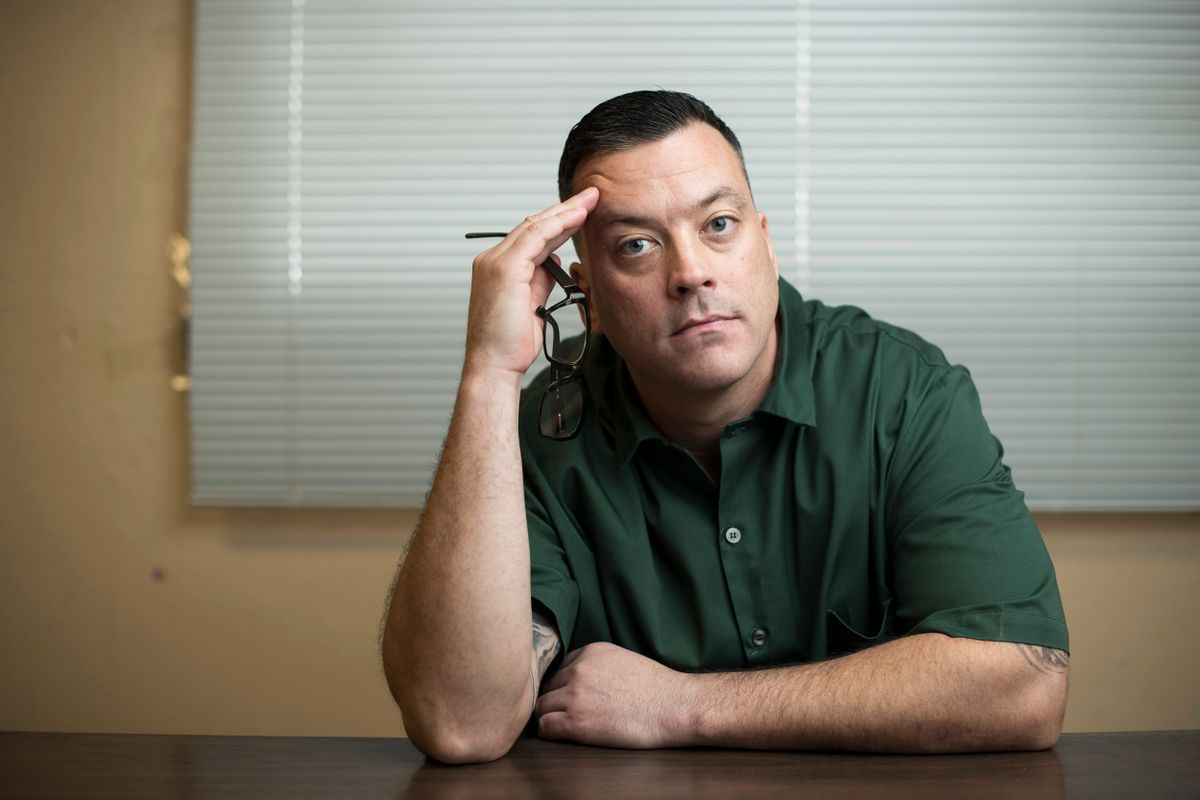Copyright The Marshall Project

While serving a sentence of 28-years-to-life in New York State prisons for killing a rival drug dealer, John J. Lennon has published works of journalism in a wide range of mainstream publications, including The Marshall Project. His first book, “The Tragedy of True Crime: Four Guilty Men and the Stories That Define Us,” newly published by Celadon Books, examines firsthand the cases of four killers — including Lennon himself — to cut through the sensationalism and reveal the humanity of the people behind bars. He is currently residing in Sing Sing prison, and will become eligible for parole in 2029. Bill Keller is the founding editor of The Marshall Project, and the author of “What’s Prison For: Punishment and Rehabilitation in the Age of Mass Incarceration.” Their conversation, conducted via email, has been edited for length and clarity. Bill Keller: Prison newspapers have been around for a long time — reportedly since the debtors’ prisons of the 19th century. But incarcerated journalists who work as independent freelancers, without the support of an authorized publication, are a relatively recent trend. John J. Lennon: For much of the 20th century, most prisons had a newspaper, and whenever a jailhouse journalist gained notoriety, it was for their writing in those papers. Wilbert Rideau was perhaps the most famous prison journalist. He edited and wrote articles for The Angolite, a newsmagazine that operated in Louisiana’s Angola prison. Its best work was at the tail end of the rehabilitative era of American corrections. Rideau’s success came, in large part, from a unique relationship he had with the prison warden who would go on to run the whole prison system in the state. By the ‘90s, a more punitive era began, and most of the nation's prison presses went by the wayside. The Angolite is still running today, but it’s highly censored. San Quentin, the infamous prison in California, has the San Quentin News, the “Ear Hustle” podcast, and a media lab, where participants enjoy a collegial environment, computers, and can walk the facility. Few prisons in America offer anything like this, but what I’ve learned over the years from talking to some of San Quentin’s best writers — Juan Moreno Haines and Rahsaan Thomas and Joe Garcia — is that they preferred to publish stories in outside newspapers and magazines, to reach bigger audiences, work with professional editors, rack up clips for their CVs, and to save money for their return. (Writing for the San Quentin News earned them about $16 a week.) I would have never become a journalist if I had waited for Attica or Sing Sing to start a newspaper. The creative writing workshop I attended in Attica, taught by a Hamilton College professor named Doran Larson, showed me what good writing looked like. But it was only when I started working with professionals, like you and other editors, that I was able to better develop an eye for story and understand the importance of structure and learn how to balance my own voice in reported stories. The most important part of building a career as a journalist on the inside is building community with people — editors, writers, anyone in the literary space — on the outside. Are there things about prison that inside journalists get that outside journalists tend to overlook or misunderstand? Sure. But it’s not their fault. They lack access, both physical and personal. They can only listen to what a subject, perhaps a prisoner they visit or talk to over the phone for a story, is telling them. They can’t see the action on the ground, capture the subject in first-person scenes, observe their routines and how they exist in this world. They can’t feel this world themselves or capture the senses. Of course, traditional reporters can ask their subjects to describe prison or their backstories, and then they can reconstruct those scenes. As for the personal access, regular reporters can’t enter the narrative in the first person “I.” They don’t know how it feels to exist in prison emotionally. Even though they may not intend to, many criminal justice journalists hover from moral perches when they write about people who kill. It’s a moral superiority they can’t avoid, which is why some of these reporters don’t include their subjects’ crimes, which can be problematic. Just like true crime creators bring a specific agenda to their work — that we’re all evil, and include egregious facts to ensure their audiences agree — criminal justice reporters often do the opposite. They want to highlight the injustices of the system or make the case for reforms, and to convince their readers, they exclude facts about our crimes. I’d like to think my work lands somewhere in the middle. I regret and have remorse for murdering a man, but I also use this unfortunate identity — murderer — as a literary tool. I’m able to write about very complicated characters, other murderers, and put myself beneath them by telling the reader about my own terrible transgressions, often explaining that I’m as bad or worse than the people I’m writing about. I believe this allows the reader to better see and feel for my subjects. Journalists in the free world take it for granted that they can pick up the telephone or explore the internet to research a story and check facts. Incarcerated reporters usually have extremely limited access to those basic resources. How do you cope with these handicaps? I mean, I don’t like to whine about what I don’t have. Journalists in the past did fine work with a pen and pad and good narrative skills. Plus, I’ve never known a life with technology. I’ve been locked up for 24 years, and before that I was a criminal; I never typed an email or used a computer. To be a journalist on the inside, you need to build relationships with people on the outside. So, technically, I do use technology — I get plenty of articles for research, conduct interviews with experts and even politicians outside, which are all recorded and transcribed by AI — but it’s all done through proxies, like my longtime book publicist, Megan Posco, and my research assistant, Matt Litman. They then mail the articles and transcripts to me in prison, five pages at a time. I also have a bunch of print subscriptions, and even though I can’t see online-only content, Megan will print out pieces she thinks I may find interesting and send them to me. In 2019, we received electronic tablets from Securus, a for-profit communications company [The Marshall Project’s News Inside and Inside Story are distributed on Securus tablets in prisons and jails]. On these devices, we can access educational content and podcasts, make phone calls, type messages, and cut and paste in the draft function. It’s how I’m thumb-tapping the answers to these questions right now. You work in a high-risk environment, living in close proximity to sources and subjects. The culture of prison is not especially friendly to people who pry or share secrets. Do you sometimes face reprisals? I’ve been a freelance journalist from prison for the past 12 years, and I’ve had some hairy situations — guards tossing my cell, convicts plotting to extort me — along the way. There was no script on how to do this, and I wasn’t doing journalism as part of a prison newspaper. I was publishing in magazines and earning income. Sometimes people who lived here and worked here didn’t like that my stories illuminated the dark corners of this place: the beatings guards issued in Attica or the sports betting scene in Sing Sing. In 2020, I published a piece in Sports Illustrated. It was about prison bookies and bettors; I took readers to the sidelines of Sing Sing on football Sunday. I changed most of the names in the piece. When it came out in the Super Bowl issue, a lot of guys read it in here, and some politicked me for revealing too much. Nothing much came of it, though, until, a few months later, I was moved to a different cellblock, where I didn’t have many allies. A fella, armed with a knife, approached me in the yard and claimed my story had caused him and his crew a loss. (When it came out, guards raided the cell of a guy holding their stash, he told me, and he blamed me, because the guy shared the same made-up nickname I used for the bookie in my story.) He said I had to pay up to make it right. Extortion 101: Make the mark think he’s done something wrong, something only his money can make right. I’m in prison for killing a former friend who was shaking down one of my drug sellers, so responding the same way would suggest I hadn’t changed. And truth is, when you grow up emotionally and intellectually, you lose that impulsive edge. Now, I’m more contemplative. I had someone from the outside call the administration, and I was transferred. But that violated the prison code. In recent years, my repertoire has mellowed. I’ve pivoted to writing more true crime criticism essays and character-driven stories that subvert the traditional true crime genre. And that’s what I did in “The Tragedy of True Crime.” How would you explain the boom in true-crime narratives? Who knows what the real catalyst for the true crime boom was. Some people believe it began with “Serial,” Sarah Koenig’s hugely popular public radio podcast series, but I’m not sure that’s right. That show set off the narrative podcasting boom, but “Serial” was a “true innocence” story, which is a subgenre of true crime, and if you ask Sarah Koenig why she told the story, she’ll likely say that it was to uncover a potential injustice. The most damaging true crime story is the kind that rehashes awful violence for pure entertainment. And this style of true crime took off a few years after “Serial.” With that in mind, I do wonder if audiences were getting tired of a lot of activist criminal justice writing: Villains became victims, and everybody seemed to sound like one another, using woke buzzwords, trying to evoke shame in readers. With true crime narratives, they’re less demanding, intellectually, and in the end, I imagine, the audience feels better about living with their own secrets. We all have them. At night in my cell, I try to read before I go to sleep. I read a lot of feature magazine stories — the kind I write — and I’ve been making my way through the features that were nominated for the Pulitzer; Megan mails me them every year. I was recently getting into the piece Joe Sexton wrote for The Marshall Project, about the kid Nikolas Cruz, the Parkland, Florida shooter. The piece explores the idea of mitigation, but really, it’s about these deep themes of punishment and forgiveness. Should this kid be spared the death penalty? It’s a story that requires a lot of moral grappling for the reader, and it’s almost too much. I eventually turned on the TV, and I got sucked into this “Dateline” rerun about a fella I know who locks on the tier below me, and it was about how he killed his wife and took her money, and manipulated his kids into believing she slipped in the tub and it was all an accident. After watching it, I saw him as a foul dude, nothing else, and it was weirdly soothing, because though I am a murderer, too, I felt better than him. And I turned off the tube and went to sleep. Even for me, one of true crime’s biggest skeptics, it was easier to zone out to these lurid narratives than keep reading a piece that was challenging me. I wrote “The Tragedy of True Crime” because I wanted to tell a different story about the guilty. I’d like to think the story I tell is more illuminating, not only because I'm a narrator with this regrettable agency, but because I can investigate our truths and our motivations, without doing it from a moral perch. There is some new publishing infrastructure — The Marshall Project, the Prison Journalism Project, Pen America’s Prison and Justice Writing program — that has made writing from prison more visible. More and more prison journalists are breaking into the mainstream, too. Two men I mentor, Joseph Sanchez and Robert Lee Williams, have published in The New York Times. Christopher Blackwell, who is serving time in Washington state and started landing big pieces in 2020, has published in The Washington Post and The New York Times, and his activism has spurred policy change. Similarly, Kwaneta Harris, who writes from a Texas prison, has published pieces in Teen Vogue and Rolling Stone. When we hear from these voices firsthand, I’d like to think it affects readers. In May 2023, New York prison officials implemented a directive that prohibited incarcerated art makers and freelancers from submitting their work to outside publications without first getting permission from the facility superintendent. A reporter from New York Focus, which covers policy, told me about the new directive, which apparently hadn’t yet taken effect. I told him that I thought the new rule was contrary to established law and inconsistent with the First Amendment. As soon as the story ran, it went viral, and the directive was rescinded. Later that month, when The New York Times profiled New York Focus, they acknowledged their excellent reportage and also noted that, in this moment, “prison writing has reached a new visibility.” What’s been the most gratifying response you’ve had to something you wrote from prison? I’ve been reading many warm and thoughtful reviews of my book from writers I admire, but sometimes the most moving words come from fellow prison writers. I recently got a message from a man named Dan Grote, a writer who is locked up in Pennsylvania. He asked an editor I know to share it with me. “I’ve been in a bad, bleak place, and I needed to read ‘The Tragedy of True Crime.’ I needed to see if it is, indeed, possible for a convict to become something more than the total of his mistakes with little more than a pencil, some words, and a goal to pencil a fulfilling ending to a story everyone has written off.” I mean, what else could I ask for?



